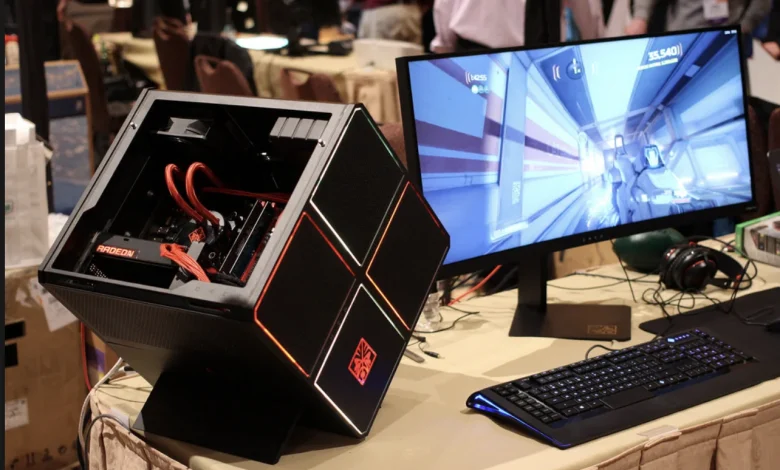The Rise of Personal Computers and Consoles: Pioneering the Golden Age of Gaming
Pioneering the Golden Age of Gaming

Introduction:
The emergence of personal computers and gaming consoles in the late 20th century marked a pivotal moment in the history of gaming. This era, often referred to as the Golden Age of Gaming, witnessed a surge in popularity and innovation that laid the foundation for the modern gaming industry. In this article, we delve into the rise of personal computers and consoles, exploring their impact on gaming culture, technology, and society.
The Birth of Personal Computers:
The 1970s saw the birth of the personal computer (PC) revolution, with pioneers like Apple, IBM, and Commodore introducing affordable and accessible computing devices to consumers. These early PCs, such as the Apple II and the Commodore PET, offered rudimentary graphics and sound capabilities but provided a platform for experimentation and creativity. Hobbyists and enthusiasts embraced these machines, using them to develop and play games in their homes and schools.
The Advent of Gaming Consoles:
Simultaneously, the gaming console industry was taking its first steps with the release of the Magnavox Odyssey in 1972, considered the world’s first commercial home video game console. However, it was the arrival of the Atari 2600 in 1977 that truly popularized gaming consoles, bringing arcade-style gaming experiences into the living room. The Atari 2600’s success paved the way for competitors like Nintendo, Sega, and Sony to enter the market, leading to a golden age of console gaming in the 1980s and 1990s.
The Evolution of Gaming Technology:
Throughout the 1980s and 1990s, personal computers and gaming consoles underwent rapid technological advancements, driving innovation in hardware and software alike. PCs evolved from simple text-based interfaces to graphical user interfaces (GUIs), enabling more immersive gaming experiences. Consoles, meanwhile, saw improvements in graphics, sound, and processing power, allowing developers to create increasingly complex and visually stunning games.
Iconic Games and Franchises:
The rise of personal computers and consoles gave birth to a plethora of iconic games and franchises that have left an indelible mark on gaming culture. From classic arcade games like “Pac-Man” and “Space Invaders” to groundbreaking PC titles like “Doom” and “SimCity,” the era produced a wealth of memorable gaming experiences that continue to be celebrated and revisited by players to this day.
The Democratization of Gaming:
One of the most significant impacts of the rise of personal computers and consoles was the democratization of gaming. Whereas arcades had once been the primary venues for gaming, PCs and consoles brought gaming into the home, making it more accessible to a broader audience. Families, friends, and individuals could now enjoy gaming together in the comfort of their living rooms, fostering social interaction and shared experiences.
Cultural Influence and Legacy:
The rise of personal computers and consoles had a profound cultural influence, shaping the way people interacted with technology and entertainment. Gaming became a mainstream form of entertainment, transcending age, gender, and cultural barriers. It inspired a new generation of creators, designers, and engineers who would go on to push the boundaries of what was possible in gaming and technology.
Conclusion:
The rise of personal computers and consoles marked a transformative period in the history of gaming, paving the way for the modern gaming industry as we know it today. The innovations and cultural impact of this era continue to resonate with gamers and enthusiasts around the world, reminding us of the pioneering spirit and boundless creativity that fueled the Golden Age of Gaming. As technology continues to evolve, the legacy of personal computers and consoles serves as a testament to the enduring power of gaming to inspire, entertain, and unite us all.
The Advent of Gaming Consoles: Revolutionizing Home Entertainment
Introduction:
The advent of gaming consoles in the mid-20th century marked a significant milestone in the evolution of entertainment technology. These dedicated gaming devices, designed to bring arcade-style experiences into the comfort of the home, revolutionized the way people interacted with video games and paved the way for the modern gaming industry. This article explores the origins, evolution, and cultural impact of gaming consoles, tracing their journey from humble beginnings to the multi-billion-dollar industry they are today.
Origins and Early Innovations:
The concept of gaming consoles can be traced back to the early 1970s when engineers and entrepreneurs began experimenting with ways to bring arcade games into the home. The Magnavox Odyssey, released in 1972, is widely regarded as the world’s first commercial home video game console. Developed by engineer Ralph H. Baer, the Odyssey featured simple games like “Table Tennis” and “Ski,” played using overlays on a television screen. Despite its limitations, the Odyssey laid the foundation for future innovations in gaming technology.
Gaming Origins and Early Innovations: Tracing the Roots of Interactive Entertainment
Introduction:
The origins of gaming can be traced back to ancient civilizations, where simple games and pastimes were enjoyed as a form of leisure and recreation. However, the modern era of gaming as we know it today began to take shape in the mid-20th century with the advent of electronic technology. This article explores the fascinating history of gaming origins and early innovations, from the humble beginnings of mechanical contraptions to the birth of digital gaming.
Early Mechanical Games:
The earliest forms of gaming can be traced back thousands of years to ancient civilizations, where games like Senet in ancient Egypt and Go in ancient China provided entertainment and amusement to players. However, it wasn’t until the 19th century that mechanical gaming devices began to emerge. Examples include the “mechanical Turk,” a chess-playing automaton created in 1770 by Wolfgang von Kempelen, and early pinball machines like Ballyhoo, which gained popularity in the 1930s. These mechanical games laid the groundwork for the interactive entertainment experiences that would follow.
The Birth of Digital Gaming:
The true birth of digital gaming can be traced back to the mid-20th century with the development of electronic computers and technology. One of the earliest examples of digital gaming is “NIM,”
a mathematical game created in 1940 by mathematician John von Neumann, which simulates a strategy game played with matchsticks. Another milestone came in 1950 with the development of “Bertie the Brain,” an early computer game that allowed players to play tic-tac-toe against an artificial intelligence opponent. These early experiments with digital gaming laid the foundation for the explosive growth of the industry in the decades to come.
The Birth of Arcade Games:
The 1970s saw the emergence of arcade games, which introduced interactive entertainment to a mass audience for the first time. One of the earliest arcade games was “Computer Space,” created by Nolan Bushnell and Ted Dabney in 1971, which was inspired by the earlier “Spacewar!” game developed by MIT students. However, it was the release of “Pong” in 1972 by Atari, Inc. that truly popularized arcade gaming, becoming a cultural phenomenon and paving the way for the golden age of arcade games in the 1980s.
The Rise of Home Consoles:
While arcade games were booming in popularity, the 1970s also saw the rise of home consoles, bringing gaming into the living room for the first time. The Magnavox Odyssey, released in 1972, is widely considered the first commercial home video game console. Developed by engineer Ralph H. Baer, the Odyssey featured simple games like “Table Tennis” and “Ski,” played using overlays on a television screen. Subsequent consoles like the Atari 2600 and the Intellivision further popularized home gaming, laying the groundwork for the modern gaming industry.
Innovations in Game Design and Technology:
Throughout the 1970s and 1980s, game designers and developers continued to innovate and push the boundaries of what was possible in gaming. Innovations like scrolling backgrounds, sprite-based graphics, and sound effects enhanced the immersion and excitement of gaming experiences. Classic games like “Space Invaders,” “Pac-Man,” and “Super Mario Bros.” became cultural icons, shaping the future of gaming and inspiring generations of players and developers.
Conclusion:
The origins of gaming can be traced back to ancient civilizations, but it was the advent of electronic technology in the mid-20th century that truly revolutionized the industry. From the mechanical contraptions of the past to the digital experiences of today, gaming has evolved and thrived, captivating audiences around the world with its endless possibilities for creativity, innovation, and entertainment. As we look to the future, one thing remains certain: the spirit of gaming origins and early innovations will continue to inspire and drive the industry forward for generations to come.
The Atari Era:
The true breakthrough for gaming consoles came with the release of the Atari 2600 in 1977. Developed by Atari, Inc., the 2600 popularized the concept of interchangeable game cartridges, allowing players to experience a wide variety of games on a single console. Titles like “Pac-Man,” “Space Invaders,” and “Pitfall!” became iconic symbols of the era, captivating players with their addictive gameplay and colorful graphics. The success of the Atari 2600 established gaming consoles as a viable form of home entertainment and laid the groundwork for future generations of consoles.
The Console Wars:
The 1980s and 1990s witnessed fierce competition between gaming console manufacturers, leading to what became known as the “console wars.” Companies like Nintendo, Sega, and later Sony entered the market with their own consoles, each offering unique features, game libraries, and marketing strategies. Nintendo’s Nintendo Entertainment System (NES), released in 1985, introduced classic franchises like “Super Mario Bros.” and “The Legend of Zelda,” cementing Nintendo’s position as a dominant force in the industry. Sega’s Genesis console, released in 1989, challenged Nintendo’s dominance with its innovative “Blast Processing” technology and iconic mascot, Sonic the Hedgehog. The rivalry between Nintendo and Sega fueled innovation and creativity in game development, leading to some of the most beloved games and consoles of all time.
Technological Advancements:
As gaming consoles evolved, so too did their technology. Advances in hardware, graphics, and sound capabilities allowed developers to create increasingly immersive and realistic gaming experiences. The introduction of CD-ROM technology in consoles like the Sega CD and Sony PlayStation enabled games to incorporate full-motion video, cinematic cutscenes, and CD-quality audio, blurring the lines between video games and other forms of media. Meanwhile, innovations like 3D graphics accelerators and online multiplayer capabilities opened up new possibilities for gaming and connectivity.
Cultural Impact and Legacy:
The advent of gaming consoles had a profound cultural impact, shaping the way people interacted with technology and entertainment. Gaming became a mainstream form of entertainment, transcending age, gender, and cultural boundaries. Consoles like the NES and Sega Genesis became cultural icons, with their games and characters leaving an indelible mark on popular culture. The rise of gaming conventions, tournaments, and fan communities further solidified gaming’s place in modern society, fostering a sense of camaraderie and shared passion among players around the world.
Conclusion:
The advent of gaming consoles marked a transformative moment in the history of entertainment technology, ushering in a new era of home gaming experiences that captivated audiences worldwide. From the humble beginnings of the Magnavox Odyssey to the cutting-edge consoles of today, gaming consoles have continued to push the boundaries of what is possible in gaming, entertainment, and technology. As we look to the future, one thing remains clear: the legacy of gaming consoles will endure, inspiring new generations of players and creators for years to come.
Introduction to personal computers and gaming consoles
Personal computers and gaming consoles have become an integral part of our lives, revolutionizing the way we work, communicate, and entertain ourselves. In this article, I will delve into the evolution of personal computers and gaming consoles, and explore their profound impact on various aspects of the tech world.
The evolution of personal computers
The journey of personal computers began in the early 1970s with the introduction of the first commercially available microprocessor, the Intel 4004. This breakthrough paved the way for smaller, more affordable computers that could be used by individuals at home or in the office. Over the years, personal computers have undergone significant advancements in terms of processing power, storage capacity, and graphical capabilities.
The impact of personal computers on communication and productivity
Personal computers have completely transformed the way we communicate and work. With the advent of email, instant messaging, and video conferencing, communication has become faster, more efficient, and more accessible. Gone are the days of relying solely on traditional mail and landline telephones. Personal computers have also revolutionized productivity by providing powerful tools for word processing, spreadsheet management, and data analysis. Tasks that used to take days or weeks can now be accomplished in a matter of hours, thanks to the speed and efficiency of personal computers.
The rise of gaming consoles
In parallel with the advancements in personal computers, gaming consoles have risen to prominence, offering a dedicated gaming experience to millions of players around the world. The first commercially successful gaming console, the Atari 2600, was released in 1977 and introduced the concept of interchangeable game cartridges. This innovation allowed players to expand their gaming libraries and experience a wide variety of games.The popularity of gaming consoles continued to soar with the release of iconic systems such as the Nintendo Entertainment System (NES), the Sony PlayStation, and the Microsoft Xbox. These consoles not only provided immersive gaming experiences but also introduced innovative features like online multiplayer capabilities and motion-controlled gaming.
How personal computers and consoles revolutionized the entertainment industry
The advent of personal computers and gaming consoles has revolutionized the entertainment industry in countless ways. Personal computers have become powerful multimedia machines, capable of streaming high-definition videos, playing music, and running complex graphics-intensive games. They have become a one-stop solution for all our entertainment needs, eliminating the need for separate devices.Gaming consoles, on the other hand, have transformed gaming into a mainstream form of entertainment. With their user-friendly interfaces and a wide range of games catering to diverse interests, consoles have attracted a broader audience beyond traditional gamers. The introduction of virtual reality (VR) and augmented reality (AR) technologies further pushed the boundaries of gaming and entertainment, providing immersive experiences that were previously unimaginable.
The influence of personal computers and consoles on software development
Personal computers and gaming consoles have played a pivotal role in shaping the field of software development. The availability of affordable personal computers has democratized programming, allowing aspiring developers to learn, experiment, and create their own software. This has led to a vibrant ecosystem of independent software developers and startups, driving innovation and pushing the boundaries of what is possible.Gaming consoles, with their standardized hardware and software platforms, have also provided a fertile ground for game developers to unleash their creativity. The development tools and software libraries provided by console manufacturers have made it easier for developers to create high-quality games for a wide range of audiences. The success of indie games and the rise of game development communities can be attributed to the accessibility and support provided by personal computers and gaming consoles.
The role of personal computers and consoles in shaping the internet
Personal computers and gaming consoles have played a crucial role in shaping the internet as we know it today. The widespread adoption of personal computers brought the internet into our homes, connecting us to a vast network of information and resources. The internet has become an indispensable tool for communication, research, and entertainment, thanks to personal computers.Gaming consoles have also contributed to the growth of online gaming communities and multiplayer experiences. The ability to connect consoles to the internet and play games with friends and strangers from around the world has transformed gaming into a social activity. Online gaming has become a phenomenon, with millions of players engaging in virtual worlds and forming communities that transcend geographical boundaries.
The future of personal computers and consoles
As we look to the future, the role of personal computers and gaming consoles will continue to evolve and adapt to new technologies and trends. With the advent of cloud computing and streaming services, personal computers and consoles are likely to become even more interconnected and integrated into our daily lives. We can expect to see more powerful hardware, improved graphics, and immersive experiences that blur the line between reality and virtual worlds.
Conclusion:
The lasting legacy of personal computers and consoles
In conclusion, personal computers and gaming consoles have undeniably revolutionized the tech world, impacting communication, productivity, entertainment, software development, and the internet. As technology continues to advance, we can only imagine the possibilities that lie ahead. Personal computers and gaming consoles have become an integral part of our lives, unleashing a power that has forever changed the way we live, work, and play.
The Rise of Home Consoles:
While arcade games were booming in popularity, the 1970s also saw the rise of home consoles, bringing gaming into the living room for the first time. The Magnavox Odyssey, released in 1972, is widely considered the first commercial home video game console. Developed by engineer Ralph H. Baer, the Odyssey featured simple games like “Table Tennis” and “Ski,” played using overlays on a television screen. Subsequent consoles like the Atari 2600 and the Intellivision further popularized home gaming, laying the groundwork for the modern gaming industry.
Innovations in Game Design and Technology:
Throughout the 1970s and 1980s, game designers and developers continued to innovate and push the boundaries of what was possible in gaming. Innovations like scrolling backgrounds, sprite-based graphics, and sound effects enhanced the immersion and excitement of gaming experiences. Classic games like “Space Invaders,” “Pac-Man,” and “Super Mario Bros.” became cultural icons, shaping the future of gaming and inspiring generations of players and developers.
Conclusion:
The origins of gaming can be traced back to ancient civilizations, but it was the advent of electronic technology in the mid-20th century that truly revolutionized the industry. From the mechanical contraptions of the past to the digital experiences of today, gaming has evolved and thrived, captivating audiences around the world with its endless possibilities for creativity, innovation, and entertainment. As we look to the future, one thing remains certain: the spirit of gaming origins and early innovations will continue to inspire and drive the industry forward for generations to come.
CTA:
Embrace the power of personal computers and gaming consoles, and explore the endless possibilities they offer in the tech world. Whether you are a programmer, a gamer, or simply someone who appreciates the transformative impact of technology, personal computers and gaming consoles are here to stay. Stay updated with the latest advancements, and be a part of the ever-evolving tech revolution. The future awaits!











